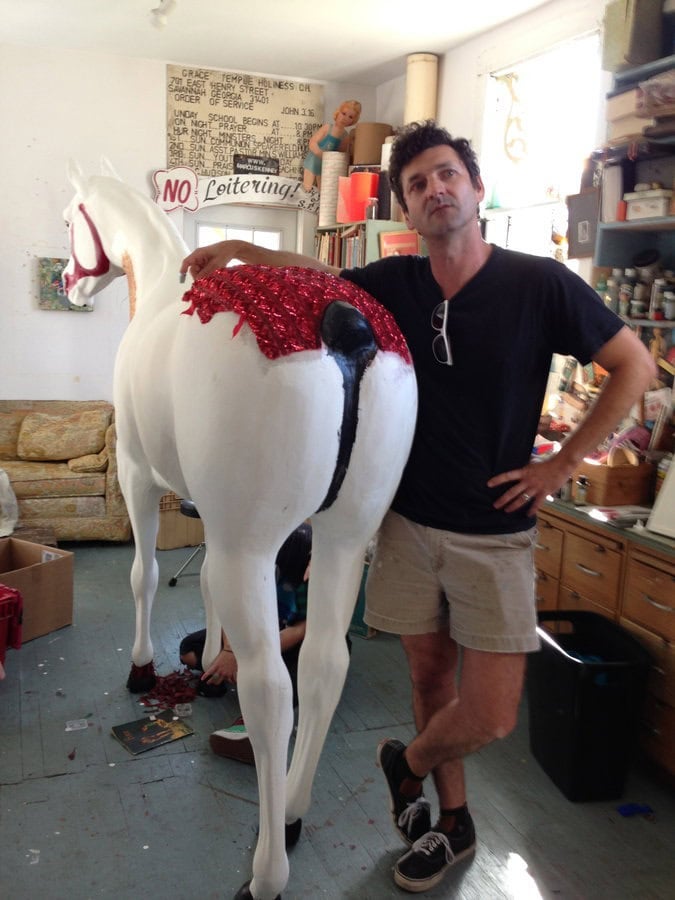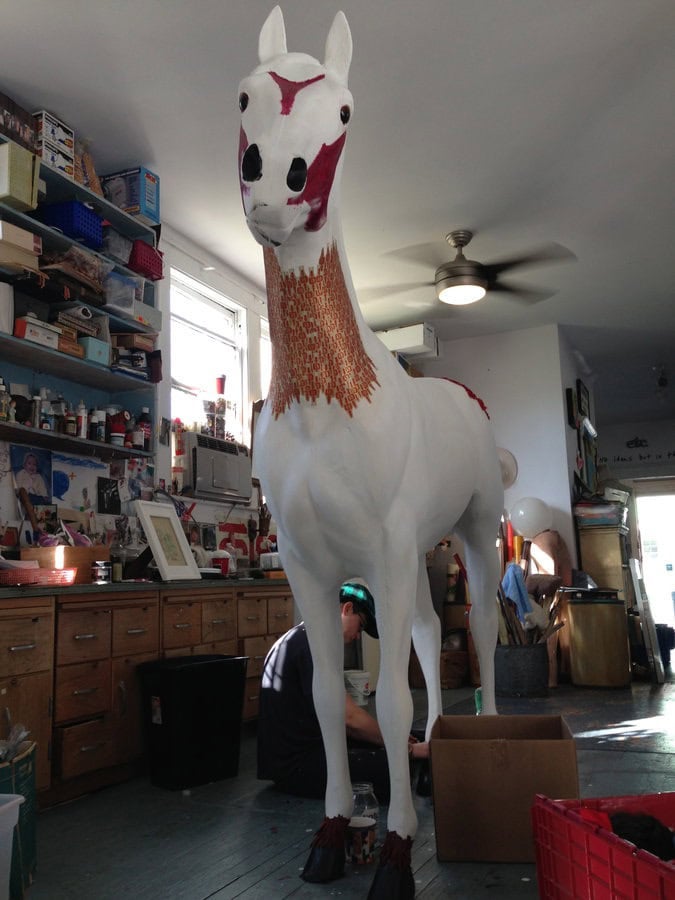
While in Savannah for the deFINE Art festival at the Savannah College of Art and Design, we paid a visit to the studio of Louisiana-born artist Marcus Kenney, known for his collage paintings comprising hundreds of stickers, product labels, and similar materials, and alchemical sculptures using vintage taxidermy and fabricated animal forms. We discussed his recent residency at the Lux Art Institute near San Diego, his artistic and biographical influences, perceptions and misconceptions about him and his work, and the art world’s senseless need for classifications. What follows is an excerpt of a longer interview that will appear in Burnaway’s second print edition, coming in late summer.
Carl Rojas: Even before I met you, I got a Southern vibe from your artwork. What makes you the Southern boy you are?
Marcus Kenney: Rural Louisiana. A little community called Cooter Point. I grew up where the Bayou Macon [pronounced “mason”] meets the Tensas River. They call it Cooter Point. My mom’s family was Cajun and they ran a little country store, and my dad’s family owned a lot of land. My dad was one of 11 children and my mom was one of seven, and both families lived in the community, so my dad was there when my mom was born.
Stephanie Cash: Physically present at the birth? What’s their age difference?
MK: Yeah, about five years. My mom’s brother married my dad’s niece, so my cousin Zeke is my double first cousin. His dad is my uncle and his mom is my first cousin. That happened a few times. My mom’s other brother married my dad’s first cousin. You’ve got eleven and seven kids, so you got a lot of possibilities in a small community. I went to the same school K through 12 in one building. I graduated with 22 kids. My parents and my two sisters both went to that school as well. We had one teacher who taught my parents, my sister, and me. It’s just a real small, rural Louisiana community.
SC: What made you want to pursue art?
MK: There’s no real answer. I drew obsessively as a child. We had three channels, and PBS was one of them, and that guy that painted—Bob Ross—I can honestly say that he was the only artist I knew.

SC: Let’s talk about some formative experiences. You recently mentioned a series of fires that had an impact on you.
MK: My mom’s house burned down when she was young. Her parents ran a little country store—they lived in the house, the store was in the front—and my grandmother had left a skillet of grease on the oven and caught the whole house on fire. It was a little wood country house that just went up in flames. She thought my mom, who was a little girl, was in the house. They had to hold my grandmother down. Then, when I was 14, my house burned down to the ground. I think I kind of became obsessed with other people’s things after that.
CR: What were the stepping stones in the nine years between graduating and your Telfair show in 2007?
MK: I actually ran a gallery here and showed some really great art—Michael Williams, Craig Drennen, Monica Cooke. It was great, but I was spending so much time focusing on that, that I wasn’t really focusing on my own work.
CR: Was it commercially viable?
MK: Of course not. It was a gallery, an artist-run gallery. We had huge parties. Cops would come. There’d be fights.

CR: Let’s talk about your subject matter. I’ve had this experience with people on more than one occasion, when, after looking at your work, they assume you’re black. Sometimes they’re disappointed; sometimes they’re not.
MK: I think most of the time they are. That’s been happening to me since the “Welcome to the South, Now Go Home” show here in 1996. There was a local person who came to that show and really wanted to meet me, and when he met me and saw I wasn’t black, he didn’t like the show anymore.
Unfortunately, it happens a lot. People get interested, then that question always comes up. It’s just stupid. They’re drawn to the work—it’s not about me. If you like something, you like it.
SC: Do you feel like you’re borrowing from an African American tradition? Where does your aesthetic sensibility come from?
MK: It’s my aesthetic. My aesthetic developed from Rauschenberg. He was my hero. He’s the reason I started doing what I’m doing. I’ve always lived in places where there is a huge black influence, in Louisiana and Savannah. To me, that’s not even an issue and it aggravates me that people find it an issue.
Someone once made the comment: Marcus is one of my favorite artists that is not in New York. Why do they have to group us? Because we don’t live in New York? You have to differentiate me because of where I choose to live? I mean, Van Gogh didn’t live in Paris.

CR: When did you start doing your taxidermy pieces?
MK: I had [an animal] trophy in my studio forever, and it was a landing place for different things, like my hat, and I thought: This could be a piece. I grew up with a trophy at my house, and on Mardi Gras my mother would hang beads on it, or Santa Claus hats at Christmas. That’s probably where it came from.
CR: Have you ever done straight painting, without using labels or stickers and the like?
MK: No, I’m always threatening to.
SC: Are you presenting a narrative, or are you just putting imagery together?
MK: There are definitely narratives. The piece I just did at Lux is the Tower of Babel, but a contemporary version, an American version. It’s a really large piece based on a Bruegel painting from the 16th century.
SC: Where you raised in a religious family?
MK: Yeah. My mom’s side, the Cajun side, is Catholic. My dad’s side is Pentecostal. We wound up going to this little church a few miles up the road. It wasn’t ultra conservative, but I did go to Sunday school, so I have all those stories floating in my head. They come up often, so I think it’s good knowledge to have. When I was in California, I’d tell people that I was doing the Tower of Babel. Most of them never heard of it. I’d say, well, it’s a story in the book of Genesis.
CR: So, what else should people know about you?
MK: They should know I’m white. Let’s get the record straight once and for all: Marcus Kenney is a 40-year-old white man.




